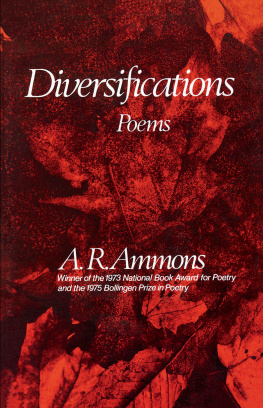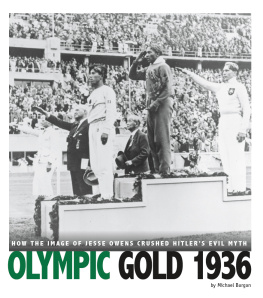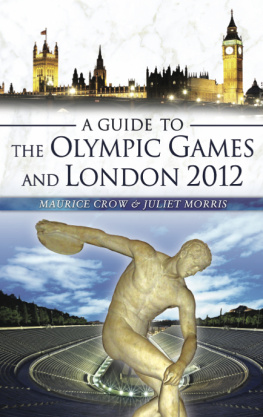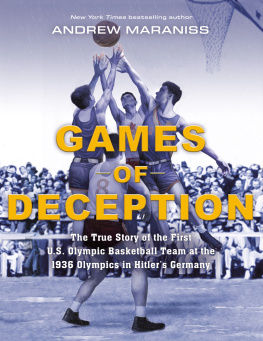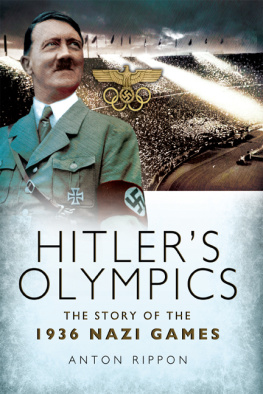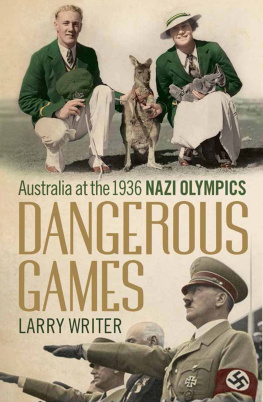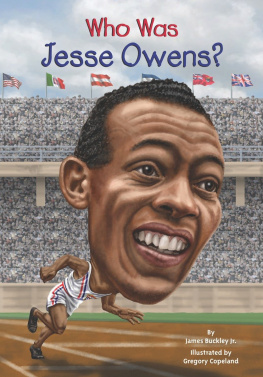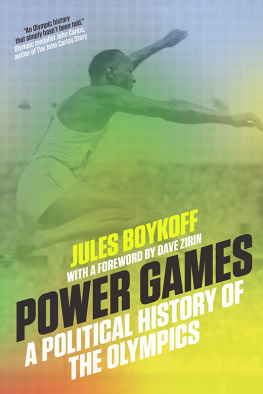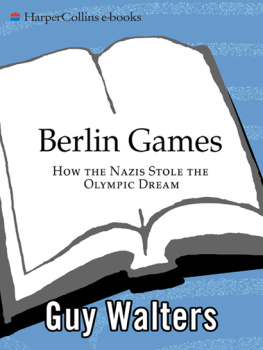


NAZI
GAMES
The
Olympics of
1936


David Clay Large

Copyright 2007 by David Clay Large
All rights reserved
First Edition
For information about permission to reproduce selections from this book, write to Permissions, W. W. Norton & Company, Inc. 500 Fifth Avenue, New York, NY 10110
Book design by Margaret Wagner Production manager: Julia Druskin
The Library of Congress has cataloged the printed edition as follows:
Large, David Clay.
Nazi games: the Olympics of 1936 / David Clay Large.1st ed.
p. cm.
Includes bibliographical references and index.
ISBN-13: 978-0-393-05884-0 (hardcover)
ISBN-10: 0-393-05884-0 (hardcover)
1. Olympic Games (11th: 1936: Berlin, Germany) 2. SportsGermany.
3. National socialism and sports. 4. Sports and stateGermany.
I. Title.
GV7221936.L37 2007
796.48dc22
2006101366
ISBN 978-0-393-24778-7 (e-book)
W. W. Norton & Company, Inc.
500 Fifth Avenue, New York, N.Y. 10110
www.wwnorton.com
W. W. Norton & Company Ltd.
Castle House, 75/76 Wells Street, London W1T 3QT
For
Joshua John Henry
and
Alma Esmeralda


Contents


Introduction
A Bridge to the Ancient Greeks?
I
Faster, Higher, Stronger
The Modern Olympics from Athens to Amsterdam
II
Enter the Nazis
III
Boycott Berlin!
IV
The Winter Games
V
On to Berlin
VI
Holy Flame, Burn
The Ceremonial Games
VII
Darktown Parade
Track and Field
VIII
Of Pools, Mats, Rings, and Rough Waters
IX
Olympia
Epilogue
The Games Must Go On


D URING the long process of researching and writing this book about the 1936 Olympics, I sometimes imagined, in more grandiose moments, that the task at hand might be nearly as arduous as actually competing in an Olympic eventsay the marathon. This project has certainly required as much support and coaching. Without the assistance of family, friends, colleagues, and the staffs of a couple of dozen research institutions, I could not have gotten through the first mile here, much less made it to the finish line.
The idea of revisiting the story of the 1936 Nazi games in light of more recent Olympic controversies, including the contentious award of the 2008 Summer Games to Beijing, came to me via my editor at W. W. Norton, Steve Forman, who then helped to push the project along at strategic moments.
My friend Howard De Nike, who is much better versed in the arcana of sports history than I am, read through the entire manuscript in its first draft, pointing out many errors and making useful suggestions for improvement. Earl Gustkey, a former sportswriter for the Los Angeles Times, also vetted most of the manuscript and shared with me his reportage on the boxer Max Schmeling. Professor Barbara Keys, formerly of Sacramento State University and currently at the University of Melbourne, read several chapters in draft and furnished me with an early version of her forthcoming book, Globalizing Sport: National Rivalry and the International Community in the 1930s (forthcoming from Harvard University Press). Joshua Large scrutinized the manuscript with the hypercritical eye of a history graduate student, a soccer nutand a son. I also profited from readings by Professors Jonathan Schneer of Georgia Tech University and Billy G. Smith of Montana State University in Bozeman. David Guss of Tufts University provided me with useful information on some of the Olympic athletes. Sue Llewellyn did an excellent job of copyediting.
While working on this book I was able to share some of my preliminary findings in presentations at Montana State University, Princeton University, Heidelberg University, Georgia Tech University, Sacramento State University, the University of New Mexico, and the Worlds Fair Symposium in San Francisco in 2005. Id like to thank Professors Billy G. Smith, Constanza Gthenke, Heiner Must, Jonathan Schneer, Barbara Keys, Christine Sauer, Charles McClelland, and Robert Rydell for arranging these occasions.
Although (thankfully) it doesnt cost as much to write about the Olympic Games as it does to put them on, the far-flung research travels for this project did not come cheaply, and I am grateful to the Research and Creativity Committee of Montana State University for a generous grant in support of my work. My thanks, too, to Professors Noel Cary, Jeffry M. Diefendorf, and Peter Fritzsche for writing in support of my grant application.
My work on this book took me to archives and libraries across the United States and Europe. For their patient assistance and invaluable expertise I would like to thank the staffs of the following institutions: Amateur Athletic Federation, Los Angeles; American Jewish Committee Archive, New York; Bibliothque Nationale, Paris; Blaustein Library, New York (especially Cyna Horowitz); British Library, London; Bundesarchiv, Berlin; Bundesarchiv, Koblenz; Bayerisches Hauptstaatsarchiv, Munich; Carl und Liselott Diem-Archiv, Cologne (especially Michael Winter and Karl Lennartz); Center for Jewish History, New York; Columbia University Library; Deutsche Sporthochschule, Cologne; Doe Library, University of California at Berkeley; Emory University Library and Archives, Atlanta; Firestone Library, Princeton University; Greene Library, Stanford University; Heidelberg University Library; Heidelberg University, Institut fr Sport und Sportwissenschaft; Hoover Institution, Stanford; Institut fr Zeitgeschichte, Munich; International Olympic Committee Olympic Studies Center, Lausanne (especially Ruth Beck-Perrenoud); Library of Congress, Washington, D.C. (especially Dave Kelly); Markt-Archiv, Garmisch-Partenkirchen; Montana State University Library; National Archives, College Park (especially John E. Taylor); New York Public Library; sterreichische Nationalbibliothek, Vienna; sterreichisches Staatsarchiv, Vienna; Politisches Archiv des Auswrtigen Amts, Berlin; Public Records Office (National Archives), London; Regenstein Library, University of Chicago; Richard Strauss Institut, Garmisch-Partenkirchen (especially Christian Wolf); Seattle Public Library; Staatsarchiv, Munich; Staatsbibliothek zu Berlin; Sterling Library, Yale University; Tulane University Library and Archives; University of Illinois, Urbana-Champaign Library and Archives (especially William Maher and Debbie Pfeiffer); Widener Library, Harvard University; Yale University Manuscripts and Archives.
Next page

